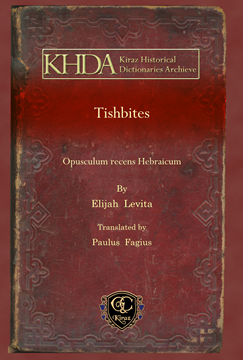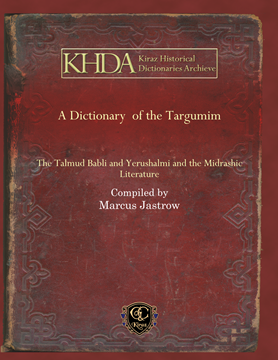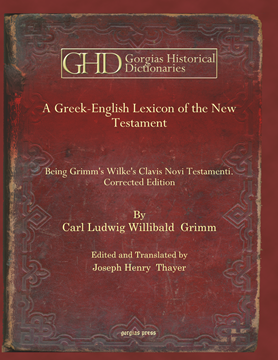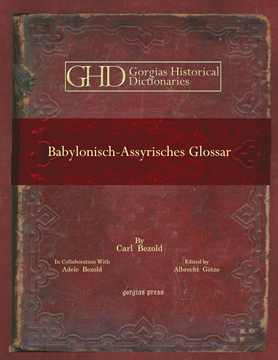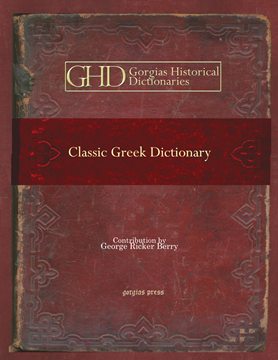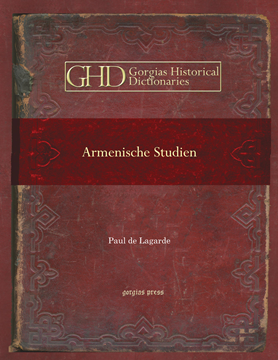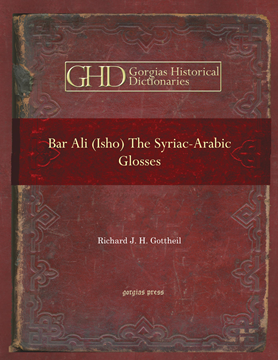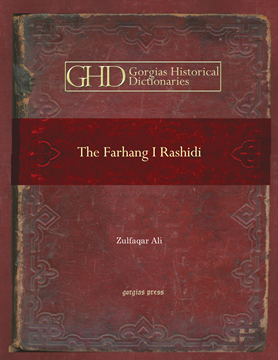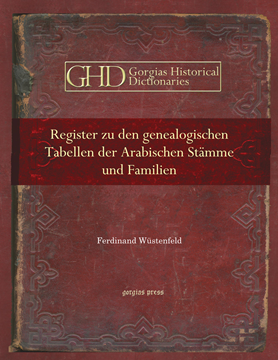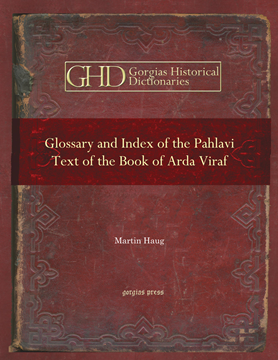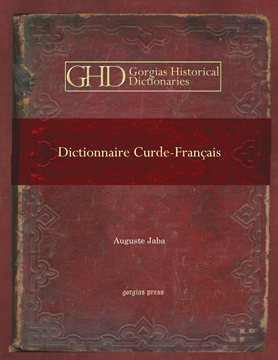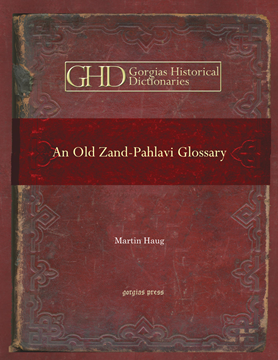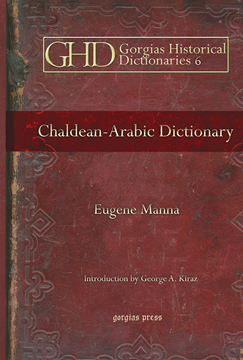Kiraz Historical Dictionaries Archive
The difficulty of locating historical dictionaries has long been a source of frustration for scholars. Gorgias Press seeks to address this difficulty by the introduction of a series of historic dictionaries.
Tishbites
Opusculum recens Hebraicum
By Elijah Levita; Translated by Paulus Fagius
Series: Kiraz Historical Dictionaries Archive 28
ISBN: 978-1-61143-294-7
This work is a collection of 712 obscure Hebrew and Aramaic words from the Talmud and Mishnah, compiled by Renaissance scholar Paul Fagius.
$210.00 (USD) $126.00 (USD)
A Dictionary of the Targumim
The Talmud Babli and Yerushalmi and the Midrashic Literature
Compiled by Marcus Jastrow
ISBN: 978-1-61143-498-9
A splendid dictionary intended for the early Rabbinic commentaries and exegesis of the Hebrew Testament: the Gemara, the Mishnah, and the Talmud.
$511.00 (USD) $306.60 (USD)
Gesenius' Hebrew and Chaldee Lexicon to the Old Testament Scriptures
By Wilhelm Gesenius; Translation and Introduction by Samuel Prideaux Tregelles
Series: Kiraz Historical Dictionaries Archive 29
ISBN: 978-1-61143-312-8
This work is a revised and expanded English translation of Wilhelm Gesenius' classic Hebrew dictionary.
$312.00 (USD) $187.20 (USD)
A Greek-English Lexicon of the New Testament
Being Grimm's Wilke's Clavis Novi Testamenti. Corrected Edition
By Carl Ludwig Willibald Grimm; Edited and Translated by Joseph Henry Thayer
Series: Kiraz Historical Dictionaries Archive 26
ISBN: 978-1-61719-677-5
This revised and expanded translation of Grimm's New Testament dictionary lists the appearances of each word in the New Testament.
$266.00 (USD) $159.60 (USD)
Babylonisch-Assyrisches Glossar
Series: Kiraz Historical Dictionaries Archive 24
ISBN: 978-1-61719-653-9
An Akkadian-German dictionary, with index detailed enough to serve as a German-Akkadian dictionary.
$170.00 (USD) $102.00 (USD)
Classic Greek Dictionary
In two parts: Greek-English and English-Greek
Contribution by George Ricker Berry
Series: Kiraz Historical Dictionaries Archive 23
ISBN: 978-1-61719-401-6
Greek-English and English-Greek dictionary with an Appendix of Proper and Geographical Names.
$353.00 (USD) $211.80 (USD)
Armenische Studien
Series: Kiraz Historical Dictionaries Archive 14
ISBN: 978-1-59333-986-9
Venturing into the realm of the Armenian language, Lagarde here presents a preliminary glossary of the language. The main body of the book contains over 2400 lexical entries, most of which are brief, dense descriptions of the words. Following the glossary Lagarde provides a comparative chart to the Armenian words including material from Sanskrit, Bactrian or Old Persian, Neo-Persian, Greek, and Semitic. An essay on the history of the study of the language and indices round out this early work on the Armenian tongue. This book, written in German, holds an important place in the study of Armenian.
$138.00 (USD) $82.80 (USD)
The Syriac-Arabic Glosses
Series: Kiraz Historical Dictionaries Archive 13
ISBN: 978-1-59333-834-3
This edition of the Syriac-Arabic glosses of Isho Bar Ali is a publication difficult to locate. These glosses are located in the second part of Bar Ali’s lexicon, as the first part had been previously published. Bar Ali, a physician as well as a lexicographer, produced this noted Syriac-Arabic dictionary showing the meanings of Syriac words in Arabic. This historic step in the development of Syriac lexicography is analyzed here according to the glosses of the numerous manuscripts cited in the forward.
$206.00 (USD) $123.60 (USD)
Coptic-Latin Lexicon
Lexicon Copticum
Series: Kiraz Historical Dictionaries Archive 8
ISBN: 978-1-59333-571-7
Peyron’s lexicon is the classic Coptic-Latin dictionary of the early twentieth century. It is of special historical importance because of the association of Peyron with Champollion, Napoleon’s epigrapher on his Egyptian voyage. Placed so early in the dawn of Egyptian studies, Peyron sheds light from an eye undimmed by the subsequent decades of scholarship.
$273.00 (USD) $163.80 (USD)
The Farhang I Rashidi
A Persian Dictionary by Sayyid Abdurrashid
By Zulfaqar Ali
Series: Kiraz Historical Dictionaries Archive 20
ISBN: 978-1-59333-916-6
The famous Persian dictionary of Sayyid Abdurrashid, now quite difficult to locate, is an historic dictionary to which linguists still make reference. The Farhang I Rashidi was compiled by the Persian scholar Abd ur-Rashid bin Abd ul-Ghafur Husaini al-Madani al-Tattawi (d. 1653) who lived in Thatta, now the Sindh province of Pakistan. One of two dictionaries compiled by Abd ur-Rashid, this lexicon, presented entirely in Classic Persian, marks a turning point in Persian lexicography and ranks as one of the cultural and literary achievements of the seventeenth century. The two volumes of this historic dictionary are here bound together, providing an affordable alternative to earlier two-part editions.
$257.00 (USD) $154.20 (USD)
Register zu den genealogischen Tabellen der Arabischen Stämme und Familien
mit historischen und geographischen Bemerkungen
Series: Kiraz Historical Dictionaries Archive 21
ISBN: 978-1-59333-940-1
In an historic attempt to map out the major tribes and families of the Arabic world, Wüstenfeld prepared this work based on three major types of documents. Taken together these sources provide a wealth of information on family names. Wüstenfeld has organized the entries for his register alphabetically, providing a starting point for current day researchers on the Arabic past.
$204.00 (USD) $122.40 (USD)
Glossary and Index of the Pahlavi Text of the Book of Arda Viraf
By Martin Haug
Series: Kiraz Historical Dictionaries Archive 18
ISBN: 978-1-59333-938-8
For the student of ancient Iranian documents, this time-honored source for using the sacred texts of the Zoroastrians, this glossary and index is an historical dictionary of an unusual sort. The materials from three works provide the basis for this glossary: the Pahlavi text of Arda Viraf, the tale of Gosht-I Fryano, the Hadokht Nask, and extracts from the Din-Kard and Nirangistan. All of these documents pertaining to Zoroastrian belief and practice are facilitated by this historic glossary. Based on the edition of E. W. West, the text was revised by Martin Haug. A work of scholarly erudition in the nineteenth century, this book, now difficult to find, has now claimed a place among Gorgias Historical Dictionaries.
$172.00 (USD) $103.20 (USD)
Dictionnaire Curde-Français
By Auguste Jaba
Series: Kiraz Historical Dictionaries Archive 17
ISBN: 978-1-59333-926-5
This historic dictionary was the first French-Kurdish dictionary ever published. Compiled by Auguste Jaba, a Polish diplomat in the Russian service in the Middle East, this lexical enterprise initiated an interest in the under-studied language of the Kurds. Entries are written in the modified Arabic script for Kurdish, and are provided with a pronunciation key and translation into French. Historians of the languages of Iraq and Kurdistan will find having this dictionary essential to the unfolding growth of knowledge about this region.
$202.00 (USD) $121.20 (USD)
An Old Zand-Pahlavi Glossary
Edited in the Original Characters
By Martin Haug
Series: Kiraz Historical Dictionaries Archive 16
ISBN: 978-1-59333-996-8
This historical dictionary contains an English translation of the Frahang-I Oim-evak, an antique Avestan and Middle Persian dictionary. A collaboration between Martin Haug and Destur Hoshengji Jamaspji, this rare glossary provides the Pahlavi translations for almost 900 Avestan words. Avestan is an Eastern Old Iranian language used by the Zoroastrian Avesta. It represents one of the earliest known Iranian languages. This dictionary was one of the earliest attempts to present the material to a western readership. Still considered a historic entry-point into the language, Haug’s glossary has become a rare find. Gorgias Press is pleased to bring it back into circulation as a part of our Historical Dictionary series.
$132.00 (USD) $79.20 (USD)
An Old Pahlavi-Pazand Glossary
Edited with an Alphabetical Index
By Martin Haug
Series: Kiraz Historical Dictionaries Archive 15
ISBN: 978-1-59333-995-1
Originally compiled by Destur Hoshangji Jamaspji Asa, this historic dictionary was revised and enlarged by Martin Haug. This edition of the glossary represents the first time that the Pahlavî-Pâzand, or Saanian Farhang, was published in its ancient form and arrangement. The dictionary is of an Aramaic translation into Middle Persian, in Pahlavi script. A substantial introductory essay on Pahlavi begins the work; entries are translated into English, occasionally reaching substantial essays. A truly historic attempt to document a language far removed from many European and new world scholars, Haug has produced an indispensable historic dictionary.
$191.00 (USD) $114.60 (USD)
Chaldean-Arabic Dictionary
Introduction by George A. Kiraz
By Eugene Manna
Series: Kiraz Historical Dictionaries Archive 6
ISBN: 978-1-59333-552-6
A historical dictionary translating Syriac into Arabic, this handy volume brings together the language of the author’s Chaldean Church and the Arabic of his contemporary culture. This scarce volume, now available in the west, is sure to be of considerable interest to scholars of Syriac and Arabic alike.
$298.00 (USD) $178.80 (USD)

